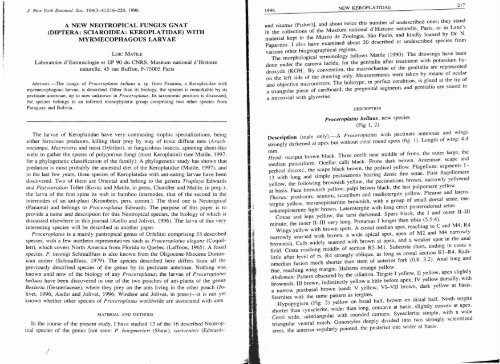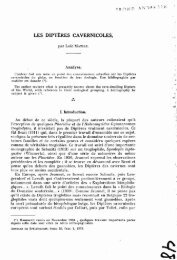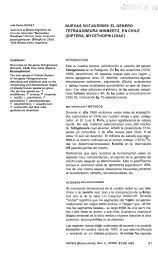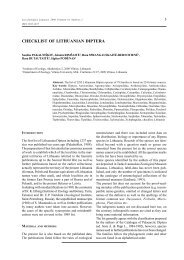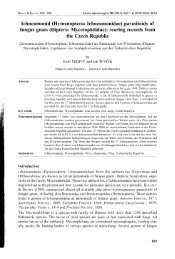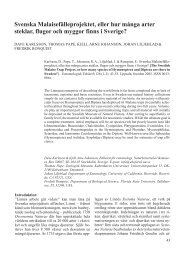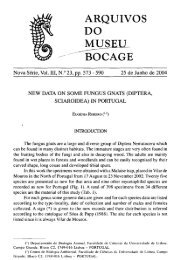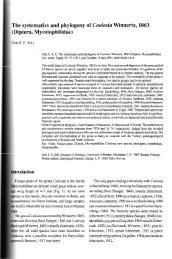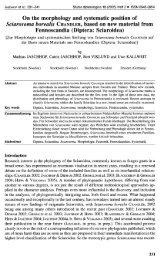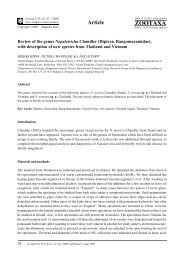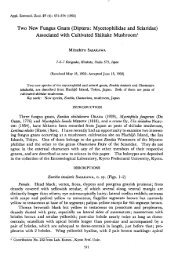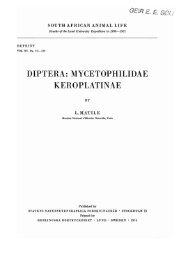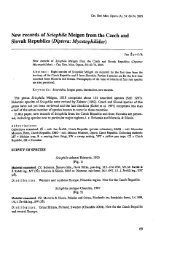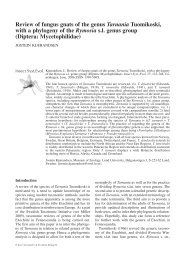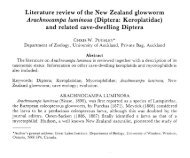diptera: sciaroidea: keroplatidae - Online Identification Keys
diptera: sciaroidea: keroplatidae - Online Identification Keys
diptera: sciaroidea: keroplatidae - Online Identification Keys
Create successful ePaper yourself
Turn your PDF publications into a flip-book with our unique Google optimized e-Paper software.
J. New York Entomol. Soc. 104(3-4):216-220, 1996 1996<br />
NEW KEROPLATIDAE<br />
217<br />
A NEW NEOTROPICAL FUNGUS GNAT<br />
(DIPTERA: SCIAROIDEA: KEROPLATIDAE) WITH<br />
MYRMECOPHAGOUSLARVAE<br />
LoiC MATlLE<br />
Laboratoire d'Entomologie et EP 90 du CNRS, Museum national d'Histoire<br />
naturelle, 45 rue Buffon, F-75005 Paris<br />
Abstract.-The imago of Proceroplatus belluus n. sp. from Panama, a Keroplatidae with<br />
myrmecophagous larvae, is described. Other than its biology, the species is remarkable by its<br />
pectinate antennae, up to now unknown in Praceroplatus. Its taxonomic position is discussed;<br />
the species belongs to an inferred monophyletic group comprising two other species from<br />
Paraguay and Bolivia.<br />
and vitattus (Fisher)], and about twice this number of undescribed ones; they stand<br />
in the collections of the Museum national d'Histoire naturelle, Paris, or in Lane's<br />
material kept in the Museo de Zoologia, Sao Paulo, and kindly loaned by Dr. N.<br />
Papavero.. I also have examined about 20 described or undescribed species from<br />
various other biogeographical regions.<br />
The morphological terminology follows Matile (1990). The drawings have been<br />
done under the camera lucida, for the genitalia after treatment with potassium hydroxyde<br />
(KOH;. By convention, the macrochaetae of the genitalia are represented<br />
on the left side of the drawing only. Measurements were taken by means of ocular<br />
and objective micrometers. The holotype, in perfect condition, is glued at the tip of<br />
a triangular piece of cardboard; the pregenital segments and genitalia are stored in<br />
a microvial with glycerine.<br />
DESCRIPTION<br />
The larvae of Keroplatidae have very contrasting trophic specializations, being<br />
either ferocious predators, killing their prey by way of toxic diffuse nets (Arachnocampa,<br />
Macrocera and most Orfeliini), or fungicolous insects, spinning sheet-like<br />
webs to gather the spores of polyporous fungi (most Keroplatini) (see Matile, 1997,<br />
for a phylogenetic classification of the family). A phylogenetic study has shown that<br />
predation is most probably the ancestral diet of the Keroplatidae (Matile, 1997), and<br />
in the last few years, three species of Keroplatidae with ant-eating larvae have been<br />
discovered. Two of them are Oriental and belong to the genera Truplaya Edwards<br />
and Platyceridion Toilet (Kovac and Matile, in press, Chandler and Matile, in prep.);<br />
the larva of the first spins its web in bamboo internodes, that of the second in the<br />
internodes of an ant-plant (Krombein, pers. comm.). The third one is Neotropica!<br />
(Panama) and belongs to Proceroplatus Edwards. The purpose of this paper is to<br />
provide a name and description for this Neotropical species, the biology of which is<br />
discussed elsewhere in this journal (Aiello and Jolivet, 1996). The larva of this very<br />
interesting species will be described in another paper.<br />
Proceroplatus is a mainly pantropical genus of Orfeliini comprising 33 described<br />
species, with a few northern representatives such as Proceroplatus elegans (Coquillett),<br />
which covers North America from Florida to Quebec (Laffoon, 1965). A fossil<br />
species, P. hennigi Schmallfuss is also known from the Oligocene-Miocene Dominican<br />
amber (Schmallfuss, 1979). The species described here differs from all the<br />
previously described species of the genus by its pectinate antennae. Nothing was<br />
known until now of the biology of any Proceroplatus; the larvae of Proceroplarus<br />
belluus have been discovered in one of the two pouches of ant-plants of the genus<br />
Besleria (Gesneriaceae), where they prey on the ants living in the other pouch (10<br />
livet, 1996; Aiello and Jolivet, 1996; Windsor and Jolivet, in press)-it is not yet<br />
known whether other species of Proceroplatus worldwide are associated with ants.<br />
MATERIAL AND METHODS<br />
In the course of the present study, I have studied 13 of the<br />
ical species of the genus [not seen: P. borgmerieri ·(Shaw),<br />
16 described Neotropvariventris<br />
(Edward~;<br />
i<br />
I<br />
Proceroplo.tus belluus, new species<br />
(Fig 1,2)<br />
Description (male only).-A Proceroplatus with pectinate antennae and wings<br />
strongly darkened at apex but without clear round spots (fig. I). Length of wing: 4.4<br />
mm.<br />
Head: occiput brown black. Three ocelli near middle of frons, the outer large, the<br />
median punctiform. Ocellar calli black. Frons dark brown. Antennae: scape and<br />
pedicel discoid, the scape black brown, the pedicel yellow. Flagellum: segments 1<br />
13 with long and simple pectinations bearing dense fine setae. First f1agellomere<br />
yellow, the following brownish yellow, the pectinations brown, narrowly yellowed<br />
at basis. Face brownish yellow, palpi brown black, the last palpomere yellow.<br />
Thorax: prothorax, scutum, scutellum and mediotergite yellow. Pleurae and laterotergite<br />
yellOW, mesanepisternite brownish, with a group of small dorsal setae, mesokatepisternite<br />
light brown. Laterotergite with long erect posterodorsal setae.<br />
Coxae and legs yellow, the tarsi darkened. Spurs black, the I and outer Il-IIl<br />
minute, the inner II-III very long. Protarsus I longer than tibia (5.5:4).<br />
Wings yelJc.w with brown spots. A costal median spot, reaching to C and M4; R4<br />
narrowly seamed with brown, a wide apical spot, apex of M2 and M4 narrowly<br />
brownish, Culb widely seamed with brown at apex, and a weaker spot in the anal<br />
field. Costa reaching middle of section R5-M I. Subcosta short, ending in costa a<br />
little after level of rs. R4 strongly oblique, as long as costal section R I-R4. Radiomedian<br />
fusion much shorter than stem of anterior fork (0.8: 3.2). Anal long and<br />
fine, reaching wing margin. Halteres orange yellow.<br />
Abdomen: Pattern obscured by the ciliation. Tergite I yellOW, 11 yellOW, apex slightly<br />
brownish; III brown, indistinctly yellow a little before apex; IV yellow dorsally, with<br />
a narrow postbasal brown band; V yellow, VI-VII brown, dark yellow at basis.<br />
Sternites with the same pattern as tergites.<br />
Hypopygium (Fig. 2) yellow on basal half, brown on distal half. Ninth tergite<br />
shorter than synsclerite, wider than long, concave at basis, slightly convex at apex.<br />
Cerci wide,subtriangular with rounded corners. Synsclerite simple, with a wide<br />
triangular ventral notch. Gonostyles deeply divided into two strongly sclerotized<br />
arms, the anterior regularly pointed, the posterior one wider at basis.<br />
/
218<br />
JOURNAL OF THE NEW YORK ENTOMOLOGICAL SOCIETY<br />
Vol. 104(3-4)<br />
1996<br />
NEW KEROPLATIDAE<br />
219<br />
[01 m"<br />
Fig. 2.<br />
Proceroplatus belluus n. sp., male holotype, synclerite and gonostyles, ventral view.<br />
Fig. 1.<br />
Proceroplatus belluus n. sp., male ho]otype, habitus.<br />
Holorype: male, "Panama, Cocle Prov. above El Cope, ex larva, 8 Nov. 1992 (10<br />
livet, Windsor, Aiello)/Ant-eating larva on silk inside inflated Ivs of Besleria jormicaria.<br />
Adult fly 3 Jan 1984 Aiello Lot 92-87 #3." Museum national d'Histoire<br />
natureJle, Paris.<br />
Etymology: From the Latin belluus, monster, as the larva of this species was firsr<br />
nicknamed by its discoverers.<br />
DISCUSSION<br />
In his very short generic description, Edwards (1925) mentioned the antennae of<br />
Proceroplatus as "much flattened, the flagellar segments deeper than long, and generally<br />
articulated above the middle." This is the condition of the males of all known<br />
species except the present one (the state of the character is attenuated in females).<br />
Pectination has appeared several times in different clades of the Keroplatinae and<br />
the Sciaroidea (see Matile, 1990:395, for a discussion of this character and its re-<br />
1<br />
partition), and no other imaginal character has been found to support a generic<br />
distinction between the species described here and the rest of Proceroplarus. A<br />
similar situation exists in the mycetophilid genus Metanepsia, from the Old World<br />
tropics, where the male flagellum is very similar to Proceroplatus, except for an<br />
Afrotropical species that has pectinate antennae (Matile, 1980).<br />
The two-armed structure of the male gonostyles of P. belluus is of the common<br />
Proceroplatus type, found worldwide in many species. This structure probably corresponds<br />
to the groundplan of the genus, and is therefore of little use in assessing<br />
the phylogenetic relationships of the new species.<br />
However, the description of P. varivenrris Edwards, a Bolivian species known<br />
only from tht: female holotype (Edwards, 1931), agrees rather closely with that of<br />
P. belluus, notable differences being the antennal scape and the whole palpi,<br />
"ochreous" instead of black in the Bolivian species, and the pleural sclerites entirely<br />
yellow. The coloration of the abdomen is also different, being more strikingly banded.<br />
Most Proceroplatus have pictured wings with roundish apical and marginal clear<br />
spots, usually between C and R5 and between each of the posterior veins. Proceroplatus<br />
belluus and P. variventris differ from these species by having the wing<br />
mainly clear and deprived of these round spots, while the apex of the wing is more<br />
markedly brown. A female from Paraguay shows a similar wing pattern, the main<br />
difference from the other two species being the presence of a complete transverse<br />
dark band through the posterior fork, instead of a single spot above Culb. In most<br />
Proceroplatus worldwide as well as in the Cenozoic species, the wings are orne-
220<br />
JOURNAL OF THE NEW YORK ENTOMOLOGICAL SOCIETY<br />
Vol.. 104(3-4) 1. New York Emomol. Soc. 104(3-4):221-225, 1996<br />
mented with round clear Spots which are sometimes more or less completely fused,<br />
and I have little doubt that this is the plesiomorphic state of the genus (an autapomorphy<br />
with regards to the other genera of Orfeliini). On the basis of this deviation<br />
from the groundplan, it thus can be inferred that P. variventris, P. belluus and the<br />
Paraguayan undescribed species together form a monophyletic group. It is of course<br />
impossible to know whether the males of the two South American species have also<br />
pectinate antennae, and if the biology of these species is the same.<br />
TWO NEW SPECIES OF MEGASTYLUS FROM THE NEW WORLD<br />
(HYMENOPTERA: ICHNEUMONIDAE; ORTHOCENTRINAE)<br />
DAVID B. WAHL<br />
3005 SW 56th Ave., Gainesville, Florida 32608-5047<br />
phone/fax: (352) 377-6458; e-mail dbwahl@delphi.com.<br />
ACKNOWLEDGMENTS<br />
I am very grateful to Drs Annette Aiello (Smithsonian Tropical Research Institute, Panama)<br />
and Pierre JoJivet, who gave me the opportunity to describe this interesting species and generously<br />
deposited the holotype in the Museum national d'Histoire naturelle, Paris, and to Dr<br />
Nelson Papavero (Museu de Zoologia, Sao Paulo) for the loan of the Orfeliini of Lane's collection.<br />
Thanks are heanily given to Gilbert Hodebert (Laboratoire d'Entomologie, Museum<br />
national d'Histoire naturelle, Paris) for the fine i]Justration of the habitus of the new species.<br />
LITERATURE CITED<br />
Aiello, A. and P Jolivet. 1996. Myrmecophily in Keroplatidae (Diptera, Sciaroidea). J. Ne\A<br />
York Entomol. Soc. 104:226-230.<br />
Edwards, F. W. 1925. British Fungus-Gnats (Diptera, Mycetophilidae), with a revised Generic<br />
Classification of the Family. Trans. Entomol. Soc. Lond. 1924 (J 925):505-670.<br />
Edwards, F. W. 1931. Die Ausbeute der deutschen Chaco Expedition 1925-6. Diptera. XXIII.<br />
Bibionidae and XXIV. Mycetophilidae. Konowia 10:74-78.<br />
Jolivet, P 1996. Ants and Plants. An Example of Coevolution (Enlarged Edition). Backhuys,<br />
Leiden, 303 pp.<br />
Kovac, D. and L. MatiJe. in press. Truplaya jerox, a new Malayan keroplatid from bamboo<br />
phytotelmata with larvae predaceous on ants (Diptera, Mycetophiloidea). Bull. Raffles<br />
Mus.<br />
Laffoon, J. J965. Family Mycetophilidae (Fungivoridae): 196-229. In: A. Stone, et al. (eds.).<br />
A CataJog of the Diptera of America north of Mexico. Agric. Handb. 276, iv + 1-1696.<br />
Matile, L. 1980. Nouvelles donnees sur les Metanepsia afrotropicaux (Diptera, Mycetophilidae).<br />
Revue fr. Entomol., N.S. 2(3):J 19-122.<br />
Matile, L. 1990. Recherches sur la systematique et ]'evolution des Keroplatidae (Diptera,<br />
Mycetophilidae). Mem. Mus Natl Hist. Nat., ser. A, Zool. 148: 1-682.<br />
Matile, L. 1997. Phylogeny and EVOlution of the Larval Diet in the Sciaroidea (Diptera, Bibionomorpha)<br />
since the Mesozoic. In Grandcolas, P (ed.), The origin of biodiversity in<br />
insects: phylogenetic tests of evolutionary scenarios. Mem. Mus. Nat. Hist. Nat., 173:<br />
273-303.<br />
Schmallfuss, H. 1979. Preceroplatus hennigi n. sp., die erste Pilzmiicke aus dem Dominikanischen<br />
Bernstein (Stuttganer Bersteinsammlung: Diptera, Mycetophiloidea, Keroplatidae).<br />
Stuttgarter Beitr. Naturk., ser. B 49: 1-9.<br />
Windsor, D. and P Jolivet. in press. Aspects of the morphology and ecology of two panamanian<br />
ant-plants, Hoffnumnia vesciculifera (Rubiaceae) and Besleriajormicaria (Gesneriaceae).<br />
J. Trop. Ecol., 12.<br />
Received 28 November 1996; accepted 27 March 1997.<br />
!<br />
~<br />
~<br />
;;,<br />
it<br />
Abstract.-Two new species of the orthocentrine genus Megasrylus, Megasrylus jallax and<br />
Megast)'lus panamensis. are described. Megasrylus panamensis constitutes the first record of<br />
this genus from the Neotropical Region. The systematics of New World Megasrylus are briefly<br />
discussed. Orthocentrinae are shown to be koinobiont endoparasitoids.<br />
The orthocentrine genus Megastylus is distributed worldwide with about 30 described<br />
species. As with many ichneumonid genera, this represents only a fraction<br />
of the total number of species. In the New World, no species have been described<br />
south of the United States. Dr. Annette Aiello and her colleagues in Panama recently<br />
reared a Meg:utylus from a dipterous (Keroplatidae) ant-predator. It is a new species<br />
and IS described here as Megastylus panamensis to complement the biological studies<br />
of the host. An unforeseen byproduct of this study is the discovery of a new species<br />
of Nearctic Megastylus from Arizona that was confused with petilus Dasch; it is<br />
described here as Megastylus fallax.<br />
Specimens examined in this study are in the American Entomological Institute<br />
(Gainesville, Florida: AEIC). Morphological terminology mostly follows Townes<br />
(J 969) as modified by Wahl (1989), with the exception that the "apical transverse<br />
carina" is referred to as the posterior transverse carina. MSI stands for the first<br />
metasomal segment. TI, T2, SI, S2, etc., are used for the various metasomaJ tergites<br />
and sternites. When the lengths of the body and wing are given, the values in parentheses<br />
are those of the ho]otype.<br />
NEW WORLD MEGASTYLUS<br />
The genus Megastylus is monophyletic, defined by the autapomorphies of: I) an<br />
inflated scape that has the posterior margin membranous and infolded, and 2) long<br />
notauli that extend to the mesoscutaJ center (Wahl and Gauld, unpublished ms.).<br />
Ichneumonologists have previously been aware of its presence in the Neotropical<br />
Region, although no species have been described from there. The late Henry Townes<br />
sorted out 38 NeotropicaJ species in the American Entomological Institute collection;<br />
they are distributed from Mexico to Chile. Ian Gauld (pers. comm.) has found 24<br />
undescribed species in Costa Rica alone.<br />
Dasch (1992) recognized 14 Nearctic species, dividing them into the Megastylus<br />
Group (10 species) and the Dieolus Group (4 species). These are defined as having<br />
the "anterior transverse groove of propodeum" close to the metanotum in the Megastylus<br />
Group or separated by about 0.3X the propodeal length (as measured from<br />
the metapostnotal posterior margin to the propodeal apex) in the Dieolus Group.<br />
Dasch's "anterior transverse groove" is the metapostnotum (Wahl, 1985) and the


